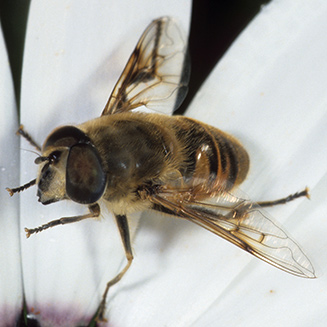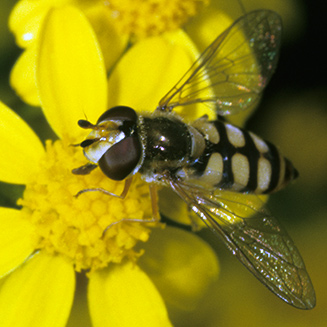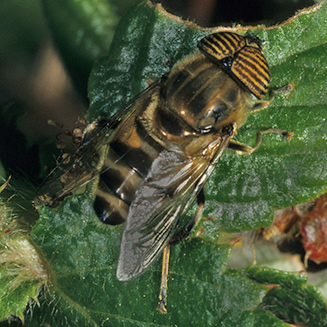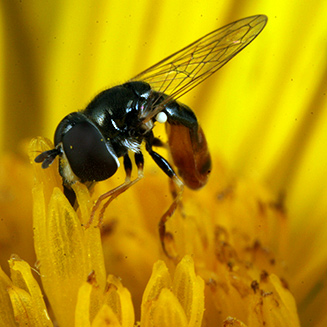|
Family: Syrphidae (hoverflies)
Life
> Eukaryotes >
Opisthokonta >
Metazoa (animals) > Bilateria > Ecdysozoa
> Panarthropoda > Tritocerebra > Phylum:
Arthopoda > Mandibulata >
Atelocerata > Panhexapoda >
Hexapoda
> Insecta (insects) > Dicondyla > Pterygota >
Metapterygota > Neoptera > Eumetabola > Holometabola > Panorpida > Antliophora
> Diptera (flies) >
Brachycera > Muscomorpha > Eremoneura >
Cyclorrapha > Aschiza > Syrphoidea
 |
 |
|
Eristalis tenax (subfamily Eristalinae), an
introduced species to South Africa. [photo Hamish Robertson] |
Eupeodes corollae
(subfamily Syrphinae) on daisy in mesic mountain fynbos.
Also introduced to South Africa.[photo Hamish Robertson] |
 |
 |
|
Eristalodes sp. [photo Hamish Robertson] |
Syrphid feeding from daisy flower in Cape Town garden.[photo Hamish Robertson] |
Subfamilies
Introduction
Hoverflies or syrphids (scientific name: Syrphidae) are
one of the most eyecatching flies. Almost everybody has seen a hoverfly either
in natural habitats or in parks, gardens or even on balconies. Many species are
more or less as big as or even bigger than houseflies and have yellow or orange
patterns (spots or bands) on their back (called abdomen). At first glance, many
of them can be mistaken for bees or wasps. Syrphids, however, are absolutely
harmless. They cannot sting nor bite.
Hoverflies are not only nice looking insects with an
interesting behavior (hovering!) but also important pollinators. The larvae of
many species act as effective predators of aphids and other insects. Other
syrphid larvae feed on a wide range of dead organic matter and act as
decomposers. As such, they make the minerals in the dead organisms available for
the living plants again.
Behaviour, life span
In South Africa the adult syrphids can be observed
throughout the year. The best season to watch them is spring and summer. Then
the adult flies find sufficient nectar and pollen in the blossoms to feed on.
All hoverflies are diurnal. They are most active in the
morning and in the afternoon when the sun is shining. At noon, temperature is
often too high for many insects. They would risk to loose too much water by
transpiration and get over-heated. The flies try to endure unfavorable
conditions (e.g. cold, rainy, stormy or hot weather) by sitting motionsless on
low plants in thick vegetation, under leaves and at other protected places.
Good places for hoverfly watching are sites with lots of
suitable flowers and egg laying sites. These are also the localities where males
and females mate. In some species the males just sit on a leaf, twig or stem and
watch their environment waiting for females. Others hover, ready to mate or
patrol those areas which females are laying eggs or feeding.
An adult fly lives just some days or a few weeks. It has
many enemies: wasps, spiders, birds, lizards, small mammals, etc. In contrast,
the life span of the larvae may last up to two (or more?) years. Health and life
span of larvae and adults can be influcenced by parasites and parasitoids. If
the physical (weather!) and biological (nutrition!) conditions are good several
species complete their life circle (egg - 3 larvae instars - pupa - adult)
within about one month.
Habitats
Hoverflies can be found in every biotope but not in
deserts. Each species tends to prefer a certain type of habitat and is limited
to a distinct range within the country. There are relatively few species with
broad habitat tolerances that enable them to be distributed throughout southern
Africa.
In general, within a genus the needs and behavior of the
species are similar. As a result, one tends to associate certain genera with
particular habitats. For example Chrysogaster, Eristalinus, and Mesembrius
(all with aquatic or semi-aquatic larvae) are typical found in wetlands, many
tiny Paragus species live in grassland whereas species of Baccha,
Melanostoma and Xylota prefer woodlands.
Within a given habitat the hoverflies have an irregular
distribution. Some prefer the low vegetation (like Melanostoma and Paragus),
others can be observed in the tree canopies (like Mallota and Spheginobaccha).
There are also differences in the horizontal distribution of the adults at a
site since important structural components like certain flowers or egg laying
sites cannot be found everywhere within a habitat.
A considerable number of species live in gardens and
public parks. The more attractive flowers (e.g. Asteraceae,
Brassicaceae, Ranunculaceae
and Rosaceae) there are growing
in a garden, the more adults there are to be observed.
To increase the number of species that reproduce in the
garden it is important to provide egg laying sites (e.g. ponts with aquatic and
dense bank vegetation, compost heaps and areas where weeds and grass are allowed
to grow). Active gardening like mowing and hacking may distroy attractive larval
habitats. Obviously, insecticides should be avoided.
As a result a garden with a great number of indigenous
syrphid species is not always that type of garden of which a traditional
gardener would be proud of. However, a little "wilderness" in a hind
corner of the garden may serve as a refugium for several syrphids without
reducing the "beauty" of paradise too much.
Distribution in South Africa
Hoverflies can be found all over the country between the
sea-shores and the mountains. In total, there are at least 180 species recorded
from South Africa. The number of species declines from the northeast to the
southwest. However, some species have only or predominately been found in the
Western Cape.
Almost all of the South African species are limited to the
African continent. Some are even exclusively known from South Africa. However,
this may be a result of poor research in neighbouring countries. A small number
of species was unintentionally introduced from Europe or / and Asia by man (e.
g. Eristalis tenax and Eupeodes corollae).
Ecology
Adults
The adults mainly feed on nectar and pollen. The females
must consume pollen since they need the proteins and amino acids of the pollen
for maturation of their eggs. Nectar has only a small amount of these substances
but much sugar. It is the fuel for the flies, enabling them to fly and hover
actively.
Being regular visitors of flowers, hoverflies are
important pollinators of various plants including vegetables and fruit trees
(e.g. Asteraceae, Brassicaceae,
Rosaceae). The flies select the
flowers mainly by their colours. They also recognize ultra-violet (UV) marks on
the blossoms.
Most of the adults have short mouthparts. Therefore
hoverflies prefer flowers with a simple anatomy to get easy access to pollen and
nectar. Many of these blossoms are white or yellow. Apparently this is one
reason why hoverflies quite often prefer white or yellow as a colour (this can
be used for recording syrphids and several other insects by capturing them in
yellow or white pan traps).
Larvae
Compared with the adults, the nutrition of the larvae is
more diverse. Three large ecological groups can be distinguished: predators,
miners and decomposers (living on dead organic material - saprophagous larvae).
All species of the subfamily of Syrphinae have zoophagous
larvae. Their main prey are aphids
(greenflies). The larvae of Microdontinae are associated with hymenopterans.
The Microdontinae larvae are supposed to be zoophagous living in ant nests.
Eumerus and Merodon larvae are plant-eating
(phytophagous) miners. They live in/at dead bulbs (in fact at least some may
feed on fungi in the decaying tissues). The larvae of the remaining eristaline
species are saprophagous organisms; they live in various habitats (running or
stagnant water, mud, compost heaps, rotten wood etc.) feeding on dead organic
substances.
Not many details are known about the ecology of the
African hoverflies. In many species the instars are still to be discovered (and
described). However, some widely distributed species (e.g. Eristalis tenax
and Eupeodes corollae) have been investigated in Europe and Asia. It can
be assumed that these species have a similar ecology in South Africa. But in
general there is a great need of specific studies of the hoverflies and their
ecological importance in (South) African habitats. But please note: before
starting a scientific study for example in the house garden one should be sure
about the identity of the observed syrphids; some common species show very
little differences in their appearance but may considerable differ in their
habits and ecology.
See life cycles of Eupeodes corollae and
Eristalis tenax.
Links
-
The world
of Syrphidae. This site gives you photos, range maps, literature, links,
messages and information about different Syrphidae projects within Europe.
Acknowledgements
The author would like to thank (the late - ed.) Dr Brian R. Stuckenberg
(Pietermaritzburg) for many valuable discussions on South African Diptera and
Dr. Adrian C. Pont (Oxford) for improving the English text of the manuscript.
Text by Werner Barkemeyer
| 